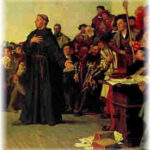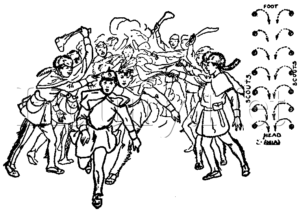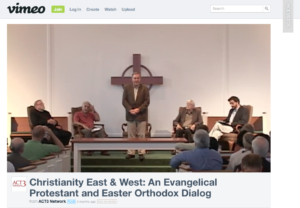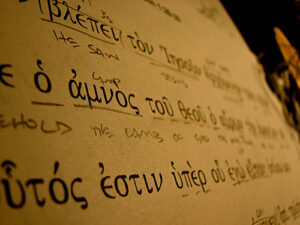FROM A READER
Recently an inquirer, interested in Orthodoxy, wrote to express his frustrations about a conversation he had with Protestants:
The problem that I kept encountering while discussing Orthodoxy with these fundamentalist Protestants is that the center of their faith is a book and not the Incarnate God-man, Jesus Christ. For example, one said: “It’s funny how he keeps trying to point to Christ and talk about how Christ is more important than Scripture. But without Scripture we don’t know Christ. He’s putting the cart before the horse. You can’t have Christ if you don’t go to God’s infallible Scripture to find Him. There is no Christ, no Christianity, no Christology, no soteriology and no other theological field of study apart from God’s infallible Word. God chose to reveal His Son through Scripture.” What is being said is only partly true, yet it is also deceptively heterodox, particularly the first sentence in red, which is what I’m calling out as iconoclastic bibliolatry! In essence, I perceive a sincere belief in the Incarnation of God the Word, yet they are saying that it is the written word that makes the Incarnation of God a reality, instead of the Incarnate Word and His theanthropic organism, the Church, that prove the veracity of Scripture; things are completely backwards and upside down, an inside out anti-Sacramental, iconoclastic bibliolatry. Please correct me if I’m wrong!
MY RESPONSE
Extreme Protestantism
What one sees in the excerpt above is an extreme form of Protestantism. The original Protestant Reformers, while they asserted sola scriptura, were also receptive to other sources of knowledge. They formulated their arguments using Scripture, philosophy, natural science, and common sense. They amply quoted the Church Fathers, especially when they supported the Reformers’ positions. Luther in his famous Here I Stand speech appealed to both Scripture and reason:
Unless I am convinced by the testimony of the Holy Scriptures or by evident reason-for I can believe neither pope nor councils alone, as it is clear that they have erred repeatedly and contradicted themselves-I consider myself convicted by the testimony of Holy Scripture, which is my basis; my conscience is captive to the Word of God. Thus I cannot and will not recant, because acting against one’s conscience is neither safe nor sound. God help me. Amen. (Emphasis added.) [Source]
Calvin’s Institutes is filled with citations from the early Church Fathers. So while the Reformers appealed to Scripture, their understanding of sola scriptura allowed for other sources of knowledge. What one finds in the Fundamentalists mentioned above is something different, a version of sola scriptura that excludes all other forms of knowledge. This is a radical departure from historic Protestantism and results in cultic Protestantism. They are not Protestants in the historic or normal sense of the word.
While the approach taken by the Magisterial Reformers is superior to Evangelicalism, problems remain. Under the Reformers’ seeming willingness to hear and even submit to the Fathers and the Ecumenical Councils is an acknowledgment that there is wisdom greater than our own reading of Scripture. Sadly, this is not what we find happening in practice. The history of Protestantism reveals the gradual unraveling of sola scriptura. Keith Mathison’s in The Shape of Sola Scriptura notes the divergence between the classic sola scriptura of the Reformers and the later solo scriptura favored by Evangelicals. The later version eschewed all other external sources, positing instead the individual Christian interpreting the Bible for himself.
Cultic Protestantism
Sola scriptura places a heavy burden on the Christian. In rejecting the papacy, Protestantism imposes on the individual Christian the responsibility for understanding Scripture. This gives rise to an independent spirit: “Nobody tells me what the Bible means!” It also paradoxically gives rise to a spirit of dependency in which one comes to rely on the pastor, favorite radio preachers, or denomination for understanding Scripture. It is the latter that gives rise to cultic Protestantism.
The term “cult” has often been used pejoratively to refer to a religious group one does not like. For this article, I define “cult” in terms of sociological traits: (1) authoritarian in structure, (2) personalistic – centered on the group’s leader, (3) lacking accountability to an independent tradition or authority, (4) suppression of critical thinking, (5) little or no tolerance for internal diversity – group think, (6) an embattled, hostile perception of the outside world, and (7) anger and hostility directed against those who have left the group.
A cult takes certain elements of a healthy church and distorts them in very unhealthy ways. In terms of architectural design, both a house and a prison have walls and doors; but where a house is designed to allow easy access and exit while protecting the residents from inclement weather, a prison is designed to prevent inmates from leaving (escaping) and is designed to maximize control over their movements. Institutions like an army encampment or a monastery can bear a strong resemblance to a prison or an internment camp, but with the former the element of free will and consent are preserved. People trapped in a cult or abusive relationships are enclosed psychologically by threats of punishment or external danger. Oftentimes, all one’s close relationships are within the cult which means that leaving will result in social abandonment – life alone bereft of meaning and direction. When engaging in theological discussions it is wise to discern whether one is talking with someone who belongs to the historic mainstream or to a cultic form of Protestantism.
Cults rely on techniques of manipulation: seduction, isolation, indoctrination, and domination. This is similar to an abusive relationship in which the man dates a woman, and then gradually and subtly compels her to sever ties with friends and family. These comprise the initial stages of seduction and isolation. The stated rationale is his love and concern for her. The woman learns to see the world the same way as the man; this is the indoctrination stage. She is discouraged from thinking independently, becoming reliant on the man for news of the outside world; this is the group think stage. In time the relationship takes a downward spiral into spiritual darkness and violence; this is the domination stage. The relationship has become a prison that is very difficult to leave. Exit is not presented as an option.
I know a man who was torn between Orthodoxy and Evangelicalism. He told me that one night he was walking by a park and saw a group singing and having a good time. It turned out to be a church group that met at the park and in people’s homes. He got into a discussion with the pastor (group leader) who would frequently ask him: “Where does it say that in the Bible?” This innocent question resembles the initial stages of seduction and isolation. A person who is spiritually hungry and seeking the truth is led down a one-way street in which the conversation is confined to what one sees in the Bible. Other sources of knowledge are subtly excluded. Here the rules of the game are subtly rigged without the other player knowing it. The seeker then has to contend with the pastor’s interpretation of the Bible. If one is ignorant of church history or has not had much education in critical thinking, one becomes vulnerable to the pastor’s “superior” insights into the Bible. I don’t know if this group was a cult or not. However, intellectual honesty calls for the inquirer to be made aware of the methods and sources being employed. Fairness requires that the players be made aware of the rules of the game. Healthy spirituality calls for a balance between the rational intellect and emotional/intuitive discernment, between individual freedom and collective authority.
So when I read the quote in the reader’s e-mail I was struck by the subtle psychological manipulations taking place. Rather than take seriously the inquirer’s attempt to take a Christ-centered approach to Christianity, his interlocutors belittled his theological method and attempted to steer him towards an extreme version of sola scriptura.
It’s funny how he keeps trying to point to Christ and talk about how Christ is more important than Scripture. But without Scripture we don’t know Christ. He’s putting the cart before the horse. You can’t have Christ if you don’t go to God’s infallible Scripture to find Him. There is no Christ, no Christianity, no Christology, no soteriology and no other theological field of study apart from God’s infallible Word. God chose to reveal His Son through Scripture.
What we see here is a full-fledged theological system with an implicit theological method: the Bible as the exclusive source for theology. What is not mentioned is the method by which Scripture will be interpreted. The exclusion of creeds, church history, theologians, and church fathers prevents one from being able to entertain alternative points of views. This leaves people not familiar with church history and with scant knowledge of the Bible at a disadvantage when discussing the Bible. In cultic Protestantism the “correct” interpretation of Scripture lies with the group leader. Rival interpretations are suppressed, sometimes through peer pressure or subtle sermonizing directed at the critic, other times through more open and coercive means like direct reprimand or even expulsion.
Orthodoxy offers a quite different approach to the interpretation of Scripture. I wrote several articles that deal with this. One article shows that what the Bible teaches is not the Bible alone, but the Bible in the context of Apostolic Tradition. And how the Holy Spirit has been guiding the Church through the centuries in its reading of Scripture.
The Bible Alone?
Probably the best way to counter extreme Protestants is to ask them: “Where does the Bible say ‘the Bible alone’?” They will likely respond with bible verses about the Bible being divinely inspired, infallible, and authoritative, but none of these verses will say that we are rely only on the Bible to the exclusion of other sources. A careful reading of the Bible will show that God allowed people to utilize human reason and other sources aside from Scripture.
Creation
The Bible often points to the beauty of creation as evidence of there being a Creator God (Psalms 8:3-5, 19:14). Paul likewise referred to Creation’s witness to God in Romans 1:20. While Creation’s witness to God is incomplete, it is a sign of wisdom for one to learn from God’s creation. God’s gift to the Jews was the divine wisdom found in the Torah (Psalm 19:7-10). When the Jews turned away from God, God used Creation as a witness against them (Isaiah 1:2-3).
Reason
The Prophet Isaiah made this appeal: “’Come now, let us reason together,’ says the Lord” (Isaiah 1:18). This was not blind obedience but an appeal for the inhabitants of Jerusalem and Judah to think about their present circumstances and future outcomes. A careful reading of Apostle Paul’s letters shows his familiarity with the techniques of argumentation used by philosophers and religious scribes of his time. Nowhere in his letters did Paul urge on his readers blind faith.
Philosophy
In his speech before the philosophers in Athens Apostle Paul quoted two Greek philosophers: Epimenides and Aratus (Acts 17:28). Paul cites Epimenides in Titus 1:12 and Menander in 1 Corinthians 15:33. The ease with which Paul could quote the pagan Greek philosophers and poets shows his familiarity with pagan Greek culture. The Apostle Paul was a bi-cultural Jew; he grew up in the world of Hellenism and received his rabbinical training in Jerusalem under Gamaliel (Acts 22:3). Paul was by no means a narrow minded Fundamentalist!
History
We find in the Bible theological arguments based on historical narratives. Stephen in Acts 7 traced the history of the Jews from Abraham to Solomon. Paul in Acts 14:16-23 traced the history of the Jews from the Exodus event to King David. In his speech before the Areopagus (Acts 17), Paul traced human history from Genesis 1 to 11. In Acts 26, we find Paul presenting his personal history to King Agrippa as a way of presenting and defending the Gospel.
There is nothing in the Bible that says we cannot learn from history after the book of Acts. As a matter of fact we would expect to see evidence of God’s sovereignty in the history of Christianity. We would expect to see the fulfillment of Christ’s promise of the Holy Spirit guiding the Church into all truth (John 16:13). The argument that the Orthodox Church has kept Apostolic Tradition throughout church history is congruent with the way the Bible uses history. Extreme Protestants are loathe to argue from church history preferring to cherry pick bible passages and constructing an elaborate theological system based on the inner meaning of the Bible that they alone are privy to.
Visions and Dreams
If the extreme Protestants are right, then all it would take for Saul of Tarsus to become a Christian would be reading the Old Testament. Instead, God walloped Paul with a blinding vision on the road to Damascus (Acts 9:3-5). Apostle Peter in his Pentecost sermon quoted the passage by Joel about young men seeing visions and old men having dreams (Acts 2:17). In Acts 10, we read how it took a vision from God to convince Peter it was kosher to visit the house of the Roman centurion Cornelius. Miraculous events like these, while not typical, show that knowledge of God can take place outside Scripture. What matters is that these miraculous events were consistent with Scripture’s witness to Jesus Christ.
Tradition
When Philip asked the Ethiopian eunuch if he understood the passage in Isaiah, the eunuch answered: “How can I unless someone explains it to me.” The Orthodox understanding is that Christ is the master Teacher who taught the Apostles the meaning of the Old Testament (Luke 24:44-49). Philip as an ordained deacon had the authority to give the Christian interpretation of Isaiah 53:7-8 to the eunuch Acts 6:5-6). In 2 Thessalonians 2:15 Paul exhorted the Christians to stand firm on Apostolic Tradition in both the written and oral forms. Extreme Protestants, on the other hand, will turn a blind eye on oral tradition. If pressed, they will insist that we don’t know what this “oral tradition” is and that it has been lost early on when the Christian Church fell into spiritual darkness. This is the Apostasy or Blink-On/Blink-Off theory of church history.
The Orthodox Church insists that it has faithfully preserved both oral and written Tradition from the time of the Apostles. What many Protestants overlook is the role of the Church in preserving the written Word of God before the invention of the printing press. We owe a great debt to the early Christians who faithfully copied the Bible and who protected the Bible against unbelievers who sought to destroy it. Moreover, we owe a debt to the early Church Fathers, who defined the biblical canon, ensuring that inspired Scriptures were made part of the Bible and spurious works excluded. We also owe a debt to the Church Fathers who guarded the Bible against heretics who distorted the meaning of the Bible.
To sum up, what we find in the Bible is a rich array of methods people used for discerning God’s will. We do not find the proof texting method much preferred by extreme Protestants. So, if one enters into a conversation or discussion and is asked: “Where does it say that in the Bible?”; the best reply is: “Where does it say in the Bible, ‘the Bible alone?’ And since the Bible does not teach that, this means we have the freedom to use our rational intellect to work through the evidence available to us like reason, church history, and the Church Fathers.”
Extreme Protestants have fallen into the same error as the Pharisees. In John’s Gospel we find Jesus explaining the role and purpose of the Bible. Jesus told the Pharisees:
You search the scriptures, because you think that in them you have eternal life; and it is they that bear witness to me; yet you refuse to come to me that you may have life. (John 5:39; RSV)
The Bible is like a street sign that points to the desired destination; it is not the destination. The scribes and Pharisees devoted so much energy studying Scripture that when the promised Messiah arrived they failed to recognize him. Similarly, extreme Protestants have become so fixated on reading the Bible in their own way that they fail to take into account Jesus’ promise to establish his Church (Matthew 16:18), protect the Church against the powers of Hell (Matthew 16:18), guide the Church by the Holy Spirit (John 16:13), and make the Church “the pillar and bulwark of the truth” (1 Timothy 3:15). They overlook the Old Testament promises of the Eucharistic sacrifice (Isaiah 56:6-7), a new priesthood for the Messianic Age (Isaiah 66:20-21), and the worldwide offering of incense in the Messianic Age (Malachi 1:11). The priesthood, incense, and the Eucharist can be found in Orthodoxy today, but are nowhere to be found in extreme Protestantism. They can claim that they have the Bible but so too do cults like the Jehovah Witnesses, the Mormons, and the Seventh Day Adventists (all which originated in the 1800s). Many extreme Protestant groups have sprung up only recently. The earnest seeker of God’s truth need to ask: “Where is the Church that Christ promised? Where is the right worship of God promised in the Old Testament prophecies?
Guilty of Bibliolatry?
Tim Challies, a Reformed pastor, noted that conservative Protestants, that is, those who affirm the inerrancy or infallibility of Scripture, have often been accused of bibliolatry by theological liberals. Then he presented what he considered to be genuine bibliolatry:
In brief, I can affirm that it is entirely possible for a person to idolize the Bible. If I were to place a Bible upon an altar, light some candles around it, and bow down before the Bible, I would be worshipping a collection of paper, ink and leather (or “pleather”). I would be idolizing a created object rather than worshipping God. This would be no better than worshipping the image of a man or animal carved from wood or stone. But this is not what is most often meant when a person accuses another of idolizing the Bible. [Source]
When I read Pastor Challies’ definition of bibliolatry, I was struck with a strong sense of irony. In every Orthodox Church on the altar is the Gospel book surrounded by candles! During the Liturgy, the priest will cense the Bible, and he will bow towards the Bible showing his reverence for the Word of God. On Sunday morning, just before entering the sanctuary, I bow before the icon of Christ and kiss the Gospel book. There is a certain irony in the fact that Protestants have accused Orthodox Christians of Mariolatry but not of bibliolatry! Here Orthodoxy goes beyond Protestantism in its outward bodily reverence for Scripture. Yet these acts of reverence do not betray any sort of “idolatrous worship” of Mary or of Holy Scripture!
Historically, Scripture was understood as a sacred deposit to be safeguarded by the Church. Before the printing press very few people had their own personal copy of the Bible. One had to go to church on Sunday morning to hear the Gospel and other books in the Bible read out loud. With the advent of the printing press in the 1400s people began to have their own personal Bibles. This was good in that many could now read the Bible and become intimately acquainted with the Bible. However, the downside of this is that many began to treat the Bible as their own personal possession independent of the Church. This gave rise to an independent spirit in which one became confident one could understand the meaning of the Bible independent of the Church. In Orthodoxy, the right understanding of Scripture is maintained through Tradition, e.g., the Nicene Creed which is recited every Sunday, the Divine Liturgy, the Ecumenical Councils and the early Church Fathers. In Orthodoxy, Holy Tradition frames Scripture and for that reason Scripture cannot be understood on its own but in the Church.
Holy Tradition prevents Orthodoxy from becoming a cult: (1) every priest and parish are accountable to a bishop the recipient of Apostolic Tradition; (2) every bishop is accountable to Holy Tradition and their respective synod of bishops; (3) lengthy catechism classes ensure one understands Holy Tradition; and (4) an open door policy in which those who disagree with the teachings of the Church are allowed to leave rather than be coerced into conformity. Added to this is Orthodoxy’s reluctance to make definitive statements on specific individual’s eternal destiny.
The Church Fathers give us insight into how Christians can have the Faith apart from sola scriptura. Irenaeus of Lyons, a second century Church Father, wrote about illiterate barbarians who, despite the absence of written Scripture, have received the true Faith through oral tradition (AH 3.4.2).
Conclusion
So, are these Protestants guilty of bibliolatry as my inquirer friend asked? My response is: (1) it all depends on what one means by “bibliolatry” and (2) in light of its negative connotations the term “bibliolatry” does not contribute to edifying dialogue. The term’s utility is further diminished by the elasticity of its meaning. Conservative Protestants have been accused of bibliolatry by liberal Protestants, and by Pastor Challies’ definition even Orthodox Christians can be accused of bibliolatry.
A more useful approach is to ask whether or not Christians may avail themselves of other sources of knowledge besides the Bible. If one takes the position that Christians are to rely solely on the Bible to the exclusion of other sources of knowledge, then one has adopted an extreme form of Protestantism. This opens the door to cultic Protestantism and to spiritual abuse. Healthy spirituality, while open to the outside world, also has boundaries. Orthodoxy has relied on Holy Tradition for the delineating of this boundary. Protestantism has long struggled with defining its boundaries, and as a consequence has suffered numerous splits over where the line is to be drawn between orthodoxy and heresy. Liberal Protestantism has extended its boundaries to the point where radical Enlightenment skepticism undermined basic Christian tenets. Extreme Protestantism, in contrast, constricted its boundaries so narrowly that it creates totalitarian cults. Popular Evangelicalism has eagerly and uncritically embraced aspects of popular culture into its worship and the way it articulates its beliefs.
We can be thankful that fundamentalist bibliolatry has not often plagued the more educated descendants of the Magisterial Reformation, e.g., Lutherans and Reformed Protestants. Yet the difficult question must be asked: “Who is more at fault for this willful high-handedness? Those familiar with the Church Fathers, the Ecumenical Councils, Holy Tradition, and who know the difference between sola and solo scriptura. Or, the provincial and less historically informed Fundamentalists?” This is not unlike asking who is more culpable of criminally abusing a 14-year old sexually curious girl? Her 17-year old boyfriend who loves her, or her 40-year old gym teacher? To whom much is given, much is required.
Redeeming the Time
One needs to exercise caution when entering into theological debates. Debates have a very different quality from a dialogue or conversation. In a debate one side wins and the other side loses. One wins by outwitting the opponent with an irrefutable argument or by presenting a fact that the other side does not know about. The weakness of debates is that they rarely result in people changing their minds. It takes more than one single argument for people to change their religious beliefs and affiliation. Formal debates are useful in that they present audiences different points of view for them to consider. Personal conversations are a much better way for inquirers interested in Orthodoxy. I often engage in lengthy theological discussions with inquirers at the local Orthodox parish. I do this to help people who are sincerely interested in becoming Orthodox, but have reservations. With sincere inquirers I don’t hesitate to enter into detailed bible discussions. If they are not at seriously interested in becoming Orthodox, I will seek to avoid debates.
I learned this lesson when I got into a debate with several members of Calvary Chapel. After a while, I came to the conclusion I was wasting my time and theirs. It can be fun, swapping bible verses and arguing what the verses mean, but for the most part very little serious learning was happening. It was more like a theological tennis match than a serious quest for God’s truth. The quest for God’s truth must take place in an atmosphere of holy reverence and prayer. I recently came across a quote on a FaceBook page that read: “Every hour that has passed is gone forever, and we must give an account of each minute of that hour.” This is similar to Apostle Paul’s admonition in Ephesians 5:16: “Redeeming the time, because the days are evil.” In light of the Final Judgment, we must beware of wasting our time in trivial activities like tossing bible verses back and forth for the fun of it. Jesus warned:
I tell you, on the day of judgment men will render account for every careless word they utter; for by your words you will be justified, and by your words you will be condemned. (Matthew 12:36-37; RSV)
A good example of people worshiping the Bible in place of Christ can be found in the Christmas story in Matthew’s Gospel. Wise men from the East guided by the star came to Jerusalem in search of the Jewish Messiah. The chief priests and the scribes quoted to them Micah’s prophecy that the Messiah would be born in Bethlehem. Then guided by natural revelation (the star) and Scripture (Micah) the wise men found the Christ Child and worshiped him (Matthew 2:1-12). It is dumbfounding that those who knew Scripture so well did not seek out Christ. The sin of bibliolatry here was knowing Scripture but failing to do God’s will. For Protestants the danger is that of revering Scripture over the Church, “the pillar of truth” founded by Christ. Cyprian of Carthage wrote:
He can no longer have God for his Father, who has not the Church for his mother. (ANF Vol. V p. 423)
The Bible and the Orthodox Church go together. The Orthodox Church has been reading Scripture and proclaiming the Gospel in its worship services from Day One. It has preserved and passed on Scripture for the past two thousand years. It reads the Bible within the framework of the Church Fathers, the successors to the Apostles. This preserves the inner meaning of Scripture. For the spiritually hungry seeker the Orthodox Church provides a safe haven for knowing Scripture.
Robert Arakaki
Tim Challies. 2006. “Feedback Files – Bibliolatry.” www.challies.com (5 July)
S.M. Baugh. 2008. “Is Bibliolatry Possible?” Resource Center – Westminster Seminary California.
Naomi Epps. N.D. “8 Signs Your Friend’s In An Abusive Relationship.” BlackLoveADvice dot Com
—- N.D. “9 Ways Groups Become Cults.” Criminal Justice Degrees Guide dot Com










Recent Comments